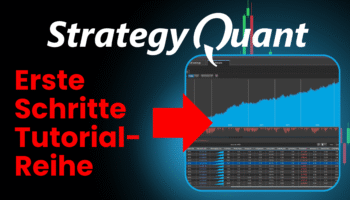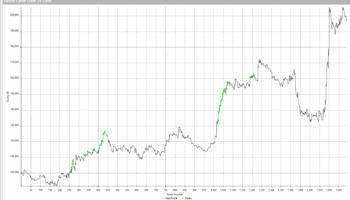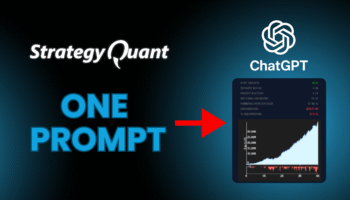There is always a big story behind when someone achieves success in markets. I am glad for the opportunity to share with you an interview with trader Grant who is part of TipToeHippo team. In this interview, you’ll learn about how they started, what results they achieved, how they created strategies, and much more. So let’s start with the first question.
How did you start with algo-trading?
The creation of TipToeHippo is similar to the famous Turtle Trading story.
The original Turtle Traders were non-traders, but highly intelligent people. One was a DnD game master, another was a fighter pilot, an accountant, a Harvard graduate et al.
These people were mentored because of a bet- that non-trading people could be taught how to trade and be successful. It turns out that they could be taught how to trade and over the next 4 years grossed $150 million in profits from the markets.
I am a software engineer specialising in pattern recognition and Dylan is a university student studying computer science but until we met Norm we struggled to find success.
Norm has been algo trading for over 10 years and serendipitously found him answering questions about algo trading on an online forum.
Dylan and I had the technical skills and once we combined our knowledge with Norm’s we began to quickly improve.
Norm was impressed with our effort and willingness to implement his advice and we formed a group friendship and began working on algos together.
We were introduced to many important concepts from Norm which we otherwise would probably not have realised without his insight. Chances are that we would have quit before success.
Thanks to a lot of hard work and research we now are successful, and recently we added our 4th TipToeHippo member. Max found us online and asked us questions about algo trading. We were impressed with his skills (he is a software engineer specialising in automation) and his enthusiasm for the challenge of algo trading.
So that’s how my algo trading started- now we have a proven profitable track record and an exciting future. There’s been some doubts along the way, but I have really enjoyed the intellectual challenge of trading.
Have you found success using SQx?
Yes. We have just passed 6 months of profitable live trading. In the 6 months of trading we have returned over 35% with a drawdown under 6%. We are very proud of that result.
The biggest indication that we have found a long term successful portfolio is that the live results have proven to be a mirror of our testing results.
Because our live results have been the same as our backtest results we are confident that these systems will continue to perform successfully into the future.
We have worked hard developing our workflow and customising indicators and other parameters of SQx to achieve this success- but we have found SQx to be a great tool to aid proper algorithmic development. This is mainly due to all the robustness tests it is capable of carrying out.
How long did it take to become successful in algo-trading using SQx?
It took me about 2 years to be successful after Dylan and I met Norm. We kept refining our ideas, improving on them, reading advice from well-respected traders and asking Norm questions.
I actually took a year off work between jobs to dedicate full time to learning algo trading. I learnt a lot during that year- it wasn’t the time I became successful but it was the time I learnt the most and laid the foundations for being successful.
So from the time I began looking into algo trading as a hobby until now, where TipToeHippo is proving successful, it’s been about 3 years. I have been utlising and customising SQx for 2 years.
What do you like the most about algo-trading?
The thing I like most is that algo-trading is about trusting the numbers.
There is no guesswork with algo trading, only evidence. Something can be tried, and if it works then the numbers will tell you.
My background is in software development so I’m comfortable having machines analyse and interpret data. Applying this to the markets just makes sense to me.
With SQx we can use modern Threadripper CPUs to crunch vast quantities of data. Because
Max and my skills lie in pattern recognition in data at our ‘real’ jobs we apply it to our trading ‘hobby’. The customisation that SQx allows gives us the opportunity to dream up new ideas and implement them into the platform. Because TipToeHippo is our hobby at the moment (until we are discovered by a big institutional fund… CALL US!) the ability to have a platform like SQx which is so powerful but also so easy to manipulate really helps us be time-efficient.
I also like that I do not have to be concerned about actually taking and managing positions. We work really hard in developing robust trading systems – that I completely trust with my own money. Having a robot trade based on statistics I find much less stressful than making the trades myself. I trust the statistical analysis TipToeHippo has done, I trust our system development process, and I trust my coding.
All these things lead to a zen like trust in our algo-trading systems.
What is your philosophy of creating an optimal portfolio?
Robustness and low correlation.
Robustness is mentioned by me a lot in this interview- but it is the single most important thing to consider when data mining to create systems. If the systems are over-fitted then no matter what is done- the portfolio is going to fail.
What is wanted is consistently profitable, robust systems with low correlation to other systems. When systems with low correlation are selected then naturally they’re going to find different parts or different types of markets to trade.
Rather than try and create one system to trade multiple markets all the time, a portfolio is different systems trading different parts of the market in multiple different ways.
We found that the more simple the system, the more robust it is. Combining low correlated systems together covers the different types of markets while remaining robust. A more complex system attempting to trade more types of markets is likely to curve fit.
The conclusion is: many simple non-correlated systems are more desirable than a single complex system.
Could you tell us more about the workflow which you are using for creating and selecting the best strategies?
Sure! I believe in giving back to the algo community, especially new people trying to find their way. That was me a few years ago and I had help from Norm amongst others- so I hope people can pick up some useful nuggets of gold in my advice now.
So a summary of our workflow is below. Obviously we don’t want to give away the specific details, but this is the summary of our process from beginning to live trading. The proof is in the profitable results TipToeHippo has achieved.
- Building a pool of strategies
- Filtering for wanted performance parameters (correlation)
- Custom fitness function
- Custom indicators
- Run robustness tests
- Sequence optimisation
- Additional markets
- Spread stress tests
- Monte Carlo
- Parameters
- Price
- Walk Forward Optimisation
- System parameter permutation
The robustness tests are the most important section of our process. We have written a complete whitepaper explaining why robustness tests are so vital. It can be found at www.tiptoehippo.com/research.
- Store surviving candidates & repeat steps 1 & 2 to build up a databank of candidates.
- Take the databank of candidates and only select one for running on the hold-out period. (Again, its vital importance is explained in the whitepaper).
- Judge performance of the hold-out period as if the system has been run live. (ie would that 6 month 25% drawdown actually have kept confidence in the system?)
If the system is rejected, the whole process is restarted from scratch deleting all previous work.
- Form portfolios using custom correlation calculations to minimise drawdown. We are especially keen to find systems that don’t lose together.
- Run on demo to confirm the forward trades = backtest trades. We will take 6 weeks of demo trades, run that same period of a backtest and confirm that the trades closely match. This confirms the validity of our tests.
- Run live. Make profits.
Every portfolio suffers from drawdown. What is your approach to overcome it and maintain confidence in your systems?
The only way to overcome drawdown is portfolio theory. For example, if we add up the combined drawdown of all our systems separately it totals 25%. However, when they are run together the maximum drawdown is 15%. The 40% reduction in drawdown is due to systems not losing at the same time.
When combining systems, not only do we look at the general correlation but also losing correlation. Winning together is fine- systems losing together in a portfolio is what we want to avoid.
To maintain confidence in our systems we use two things: robustness & historical precedent. When we know a system is robust, we know that its historical performance is a more true representation of its likely future performance. While nothing is guaranteed- robustness makes it MUCH more likely the past performance will reflect future performance.
An expectation of the portfolio and the individual systems within it can then be established.
Two different statistics are useful – drawdown percent & stagnation period to measure drawdown. Both are important.
Drawdown percent measures the size of the loss between highs and lows (including floating) while stagnation measures the time recovering from the drawdown.
Stagnation is important because when trading other people’s money (or even your own!) drawdown is not fun. The less time spent in drawdown the better.
When these two measurements are taken from a robust system the depth and the length of the drawdown is known with confidence.
The performance of systems and the portfolio can then be observed. If the performance falls outside of the historical maximum then confidence in that system is lost and its results need to be looked at closely to see if there is an explanation or if the system needs to be withdrawn or replaced.
Are there any sources of knowledge that you would recommend to other traders?
We have learnt a lot from Dr Ernie Chan (Norm did an interview with him can be found here: www.tiptoehippo.com/research ). For anyone interested in algo trading, Ernie’s books are an excellent introduction to the subject. It is written in excellent prose which Dr Chan makes points easily understandable to new algo traders.
TipToeHippo also are disciples of Dr Tim Masters. He recently retired from a career in machine learning, statistics, algo trading and a wide variety of other interesting roles. We joke he has ‘no more fucks to give’ so freely shares the knowledge he has gained over his lifetime. When he says something we pin our ears back and listen.
In the algo industry rarely do such intelligent people with such vast experience provide such wide-ranging and in-depth knowledge dumps.
There will be others out there but the most important thing when seeking out knowledge is to verify its authenticity. Confirm that the person knows their topic.
Do you have any tips on what to be aware of or avoid in algo-trading?
The single biggest thing, that isn’t immediately obvious to someone new to algorithmic trading is – be aware of and avoid overfitting.
When considering systems, select the most robust systems- not simply the systems that performed best in historical testing. It is easy to create historical tests with results that compound to the moon- however it is unlikely that these systems will perform when put on a real live account.
Realising this is the key to success. It is not easy to accept that the best looking curves might not bring the best results. The biggest banks with the smartest computer scientists fall into this trap. In other areas of computer learning/data mining overfitting is not the major barrier to success it is in financial trading (in fact it is often the reason for success).
We have written a whitepaper as an introduction to the different robustness tests and why they are important. It is available from our website here: www.tiptoehippo.com/research
Solve the overfitting problem with proper robustness testing and you are well on your way to success.
Would you like to share some recommendations to other algo-developers, what to focus on, etc.?
My recommendation is to enjoy the challenge. Algo trading is hard- creating great looking historical results is easy. Figuring out how to know if those historical results will work into the future is a great mental exercise.
I do algo trading part-time, I guess you could say I am a night-time entrepreneur offering trading signals through TipToeHippo. However this all started off as a hobby or an intellectual curiosity; using my programming skills to trade the finance markets.
This game is a hard one, but it’s rewards are great. It requires a different type of thinking about problems to many other things I’ve been exposed to. Finding others who are also thinking through these problems is very useful, allowing ideas to be thrown about and cultivated.
If you find experienced algo traders willing to share their knowledge- listen to them. Without coming together as a team with Norm’s experience I might never have harnessed my skills to success in algo trading. So visit forums and Discord rooms and ask questions of algo traders with a proven historical record. If they answer then pay attention to what they’re telling you.
Do it for the intellectual curiosity and you may find success.




Thanks Grant well done on your success ,inspirational please in the future could you give more Guidance regarding your WFM methodology within SQX
Thank you !!!! This is excellent !!! very informative, very helpful !!! Thank you very much.